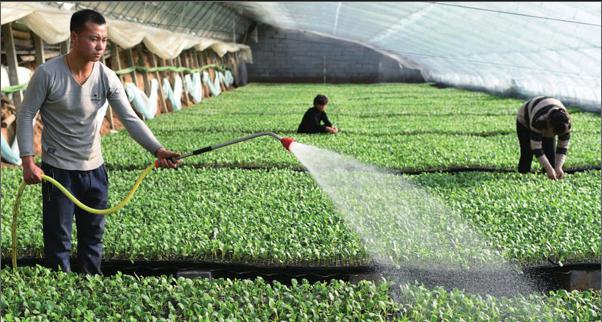China Moves to Eliminate Poverty by 2020
2018-02-09

Chinas poverty relief campaign has achieved great progress, which has attracted world attention. William Jones, Washington Bureau Chief of Executive Intelligence Review (EIR) News Service, shared his views on Chinas poverty alleviation work with Beijing Review. His opinions follow:
Through the ages, men of good will have been troubled by the sight of abject poverty and often felt that if they had the means, they would seek to rid the world of poverty. Until now, this wish has been mainly seen as a noble, but fundamentally unrealizable goal. But the commitment of the Communist Party of China (CPC) to eliminate poverty in the country by 2020, reiterated in the strongest terms by Chinese President Xi Jinping at the recent 19th CPC National Congress, is about to make that dream a reality in the most populous nation in the world.
And the track record of the CPC is strong in this regard, raising over 700 million people out of poverty since the reform and opening up was introduced in 1978. This is an absolutely astounding figure, unprecedented in all of human history, and the fi gure represents 70 percent of all the people who have been brought out of poverty during the period. Estimates have it that there are still around 30 million people in poverty in China. The commitment is to bring 10 million people out of poverty each year, which would allow the country to reach its poverty alleviation goal by 2020. And there are few who doubt that this will be accomplished.
Mobilizing the nation
The advantage that China has in this endeavor is the ability of making poverty reduction a commitment of the entire nation. This is largely due to the dominant role of the CPC, which has set itself the goal of achieving that result. But, more importantly, it has been the determination of the Party leadership, led by General Secretary of the CPC Central Committee Xi Jinping, to make poverty reduction the number one priority for the nation which has created the impetus for this development.
The necessary prerequisite for even envisioning such a program has been the revolution in connectivity over the last 20 years. The development of the high-speed rail system and the creation of new roads and highways, even in the more remote rural districts, have brought the nation much closer together, with easier communication between the major centers and the rural districts. The connectivity is also characterized by wider access to the Internet and wireless phone networks, even in the more remote areas of the country. Internet Plus is now being implemented to bring to bear online philanthropy which could supplement the major efforts of the central and local governments in bringing about poverty reduction. The Internet Plus platform has 100,000 registered donors connected to 40,000 needy families, although it has only been established in 11 cities thus far.endprint
Targeted poverty reduction
Poverty in China is primarily rural poverty. Hong Tianyun, Deputy Director of Chinas State Council Leading Group Office of Poverty Alleviation and Development, in a speech in July 2017, pointed to three geographical areas, three autonomous prefectures and three demographic groups that were still suffering from extreme poverty. The geographical areas are situated primarily in minority areas in Tibet and Xinjiang Uygur autonomous regions, as well as Sichuan and Yunnan provinces. The three demographic groups most affected by poverty are those who are impoverished because of illness, those who are impoverished as a result of natural disasters or because of market fluctuations, and the elderly poor, who because of their age or inability to work have to be fully supported by social insurance.
Given that poverty primarily affects the rural areas, the rural vitalization program and the ongoing land reform have contributed mightily to raising the standard of living in rural China. Presently the program is based on the notion of “targeted poverty alleviation” focusing on the groups and the districts which are still suffering from extreme poverty.
With greater flexibility for migrant workers in cities to lease their land holdings in their villages, it is now possible for farmers to combine smaller holdings into larger plots, making possible the use of farm equipment and other economies of scale. With an increasingly tight job market in the major cities for the numerous college graduates each year, many of them find their way to the countryside, where they have the opportunity to use their skills to help farmers in forming cooperatives and introduce them to the use of the Internet and e-commerce in order to create a broader market for the sale of their products. Combining the technical expertise and entrepreneurial spirit of the many young graduates coming to the countryside with the practical knowledge of the local farmers often results in greater output and income for entire villages. In some instances, farmers have agreed to concentrate on a particular crop, which can then be sold more profitably to the wider market.
The increased use of irrigation has also enabled what had been barren fi elds to be brought into cultivation. In many villages, smaller industries have set up operations, sometimes connected with food processing or other fields related to agriculture, creating new job opportunities for the local population. And with the improvement of the road system, these rural areas, sometimes in very beautiful locations, also become attractive for tourists both from China and abroad, creating a whole new industry for the rural population.endprint

The general thrust of the poverty reduction has been to bring development to the villages. But, in some cases, this is not feasible. Villages which are located in really difficult terrain, or simply lacking any decent roads or highways, may prove impossible to bring into the mainstream of commerce. In these cases, people are encouraged to move to areas nearby which are more accessible, and they are then provided with new and modern housing. If they have no skills that can be utilized in the new environment, training courses are set up to provide them with skills, or job opportunities like forest rangers are created, by which they can earn a decent livelihood.
This has been accompanied by a general upgrade of the conditions of life in the villages. New housing is being built. Running water and sewage systems are being put in place. Electricity is being brought into areas that didnt have it. The social welfare net is constantly expanding. And while basic education is universal and free, the quality of education in the villages can vary greatly. There is now a concerted effort to recruit new teachers from city colleges and universities to come and teach in the villages. And the effort is national in scope. The poorer sections of the country are being aided by the more prosperous urban centers, which are providing funds, skilled professionals, innovative ideas, and business investment.
Local offi cials are also required to keep close track of each of the families in their villages, monitoring their situation and making sure that they are not falling back into poverty, and analyzing the condition of those who still remain in poverty in order to come up with solutions to their particular dilemma. The cooperation between the Central Government and the local government and village Party officials is the key in this respect, as many of the problems of local poverty cannot be resolved by a onesize-fi ts-all solution.
The Chinese experience
The Chinese model of poverty alleviation has become a beacon of hope for a large part of humanity. More than half the worlds population lives in relative poverty, on less than $2.50 a day. More than 1.3 billion people live in extreme poverty—on less than $1.25 a day. The statistics are staggering. But the accomplishment of China in this respect may be a light at the end of the tunnel. Other countries can draw some important thought from the Chinese model.endprint
Firstly, there has to be fi rm determination from the central leadership to actually eliminate poverty. And this determination must be inculcated at every level of government. The entire nation has got to be mobilized for such an effort. Secondly, connectivity is absolutely essential—a daunting task in areas of Africa and Latin America, where roads and highways are often lacking. And thirdly, there must be a commitment by the countrys intelligentsia to contribute to this process as doctors, teachers and entrepreneurs who are prepared to venture to the countryside in order to help the people develop.
The good news is that nations preparing to launch such a project will not be alone. China in particular has already initiated such development projects in connection with the Belt and Road Initiative, which is also making great headway in Africa and Latin America. The United Nations has poverty alleviation as one of its Millennium Goals. And French President Macrons commitment during his recent visit to work with China in developing Africa is a major step in the right direction. It would well benefi t other countries, including the United States with its estimated 41 million people in poverty, to join the club. With a concerted effort, the Chinese example can become contagious and lead us in the direction of a community with a shared future for mankind that President Xi has so warmly espoused.endprint
